Your content’s visibility is no longer just about ranking on Google. It’s about appearing in the answers generated by Large Language Models (LLMs) like ChatGPT, Perplexity, and Google’s SGE.
But traditional SEO tools like Ahrefs and Google Analytics can't track this.
They can’t tell you if an LLM cited your blog as a source, recommended your product in an itinerary, or misrepresented your features. This visibility gap means you're operating blind, unable to measure the ROI of your AI-focused content. To succeed, you must move beyond old metrics and start understanding your digital share of visibility in these new AI channels.
This guide provides an in-depth analysis of the platforms built to solve this exact problem. You'll find detailed breakdowns, real-world use cases, and honest pros and cons for each leading ai visibility metrics platform to help you select the right solution.
1. AI SEO Tracker
AI SEO Tracker is a leading ai visibility metrics platform engineered for the new era of search. While old tools focus on blue link rankings, this platform answers the critical question for modern marketers: is your brand visible in AI-generated answers? It provides specialized tracking across essential LLMs like ChatGPT, Gemini, Claude, and Perplexity.
This focused approach delivers actionable intelligence. It gives SaaS and B2B marketing teams a direct way to measure and improve visibility where high-intent queries are now being answered.
Key Features and Use Cases
AI SEO Tracker’s features directly address the challenges of AI-driven search.
The AI SEO Page Inspector is a standout capability. It scans any URL, reports precisely what content an AI model can parse, and then provides concrete recommendations. For instance, it might suggest adding a static pricing table to increase the likelihood of being cited in a competitor comparison.
The platform's dashboards give a clear view of your AI Share of Voice, benchmarked against competitors. This lets content strategists identify and close critical content gaps. A built-in Revenue Calculator helps connect these visibility efforts to business outcomes by estimating the potential ROI from increased AI-driven traffic. To understand how SEO tracking tools contribute to visibility, you might also explore platforms like this SEO Score Checker.
Why It's a Leading Choice
Built by SaaS marketing professionals, AI SEO Tracker is laser-focused on outcomes. It is one of the few platforms that tracks visibility across multiple major LLMs, providing a complete view of your AI presence. This makes it an indispensable tool for any brand aiming to dominate "best X for Y" queries. For those looking deeper, the platform's team offers insights on their blog covering the best AI SEO tools.
- Best For: SaaS marketing teams, SEO managers, and digital agencies focused on winning visibility in AI search.
- Pros: Unique multi-LLM tracking, actionable content recommendations, and a clear focus on revenue-driven metrics.
- Cons: Pricing is not publicly listed, requiring a direct inquiry. Its specialized nature may present a learning curve for those new to AI SEO.
Website: aiseotracker.com
2. LangSmith by LangChain
LangSmith is an LLM observability platform from the creators of the popular LangChain framework. While many platforms track external search visibility, LangSmith provides an "inside-out" view, making it an essential leading ai visibility metrics platform for teams building their own AI applications.
It helps you trace, monitor, and debug complex LLM chains and agentic workflows.
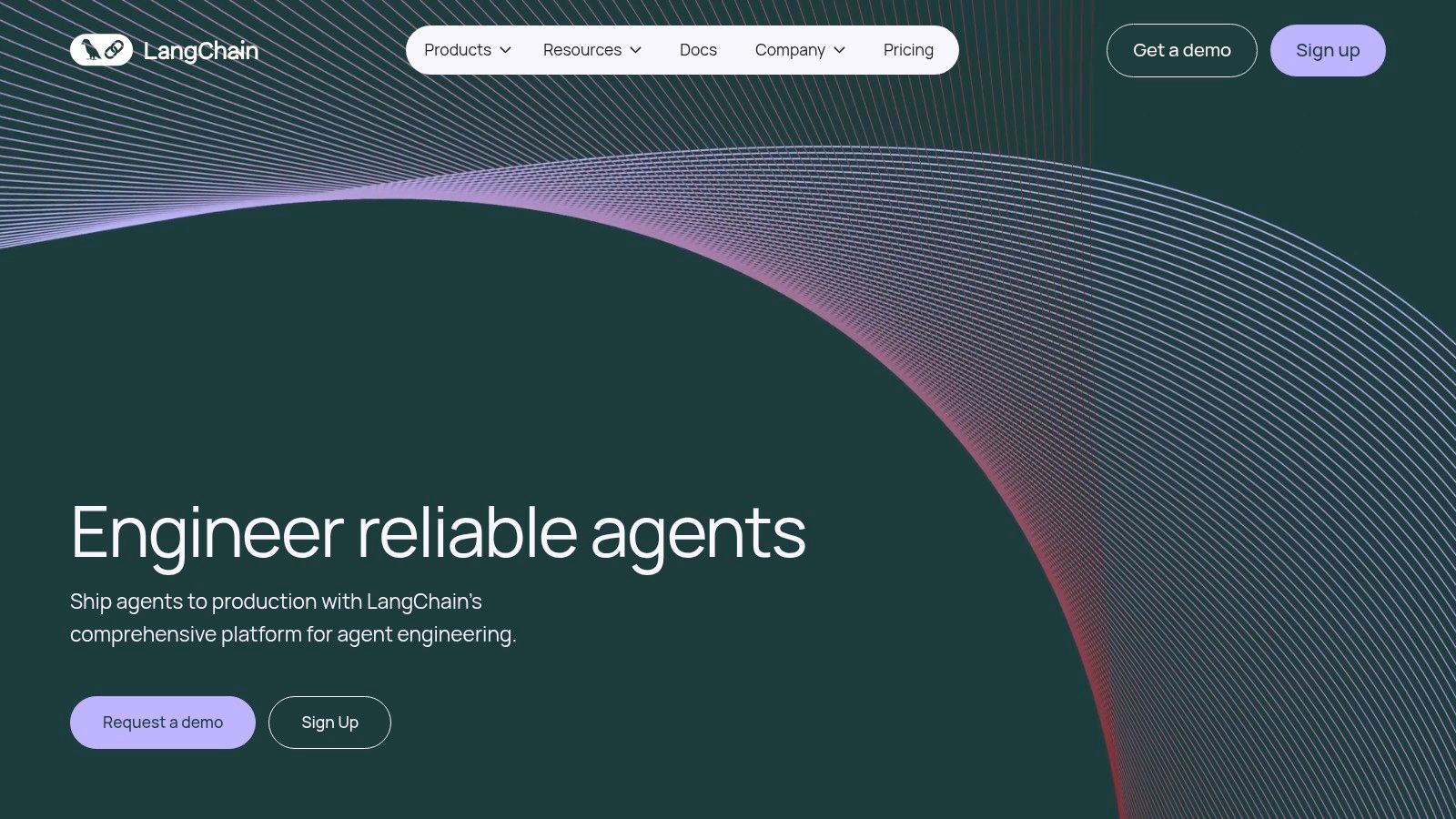
Its strength lies in deep integration with the LangChain ecosystem. It captures every step of an agent’s execution, from the initial prompt to the final output. This granular visibility is crucial for optimizing performance, reducing latency, and ensuring factual accuracy.
Key Features and Use Cases
- Online/Offline Evaluation: Collect production data to create datasets for testing new prompts or model versions. A SaaS team can test how a new version of their support chatbot handles complex user queries before deploying it, using real-world conversation examples from the last 30 days.
- Human-in-the-Loop Feedback: Implement annotation queues where team members can review, score, and correct AI-generated outputs. This is ideal for fine-tuning a content generation tool by having editors rate the quality of its drafts.
- Prompt Hub & Playground: A centralized space to manage, version, and test prompts. This helps teams collaborate on optimizing the instructions given to their AI models for better results.
Pricing and Access
LangSmith offers a transparent, usage-based pricing model. The free "Dev Plan" includes 5,000 traces per month, which is excellent for initial development. The paid "Plus" plan starts at $0.005 per trace and offers extended data retention options.
- Pros: Deeply integrated with LangChain, clear public pricing, startup-friendly options.
- Cons: Best experience is for teams already committed to the LangChain framework; costs can scale with high trace volumes.
Website: https://www.langchain.com
3. Arize AI (Phoenix + Arize AX)
Arize AI is an ML and LLM observability platform that excels in providing deep, end-to-end visibility into AI systems. It offers a powerful combination of its open-source tool, Phoenix, and its managed cloud service, Arize AX. This dual offering makes it a versatile leading ai visibility metrics platform for teams that want flexibility, from self-hosting to a full-service SaaS solution.
Its core strength is its adaptability. A data science team can start with the open-source Phoenix library to trace and evaluate LLM applications during development and then graduate to the managed Arize platform for production monitoring. This flexibility allows for deep analysis of traces, costs, token usage, and even multi-modal data.
Key Features and Use Cases
- Open-Source & Managed Cloud: Use Phoenix for local development and evaluation, then transition to the Arize cloud platform for enterprise-grade production monitoring. This allows a marketing team to test an AI-powered content personalization engine locally before deploying it into the main SaaS product.
- Custom Monitors & Metrics: Go beyond standard metrics by creating custom monitors to track specific business KPIs. For example, a growth team could build a monitor to track how often their AI sales assistant successfully books a demo, tying model performance directly to revenue goals.
- Human Annotation & Online Evaluation: Integrate human feedback loops directly into the platform to score model outputs. This is perfect for improving an AI-driven ad copy generator by having marketers rate the effectiveness of different creative variations.
Pricing and Access
Arize provides a "Free" tier for its SaaS platform that includes one user, 10 models, and 7-day data retention. The "Pro" and "Enterprise" tiers offer more users and longer retention, with usage-based pricing for spans and data ingestion. The Phoenix library is completely open-source.
- Pros: Flexible deployment with free open-source and SaaS options, powerful custom monitoring capabilities, startup-friendly discounts.
- Cons: Free SaaS tier is limited to a single user; costs can increase based on data volume and traces.
Website: https://arize.com
4. Datadog LLM Observability
For teams needing a holistic view of their entire tech stack, Datadog LLM Observability integrates AI performance monitoring directly into its well-established application performance monitoring (APM) platform. This approach provides a unified dashboard where you can track everything from user-facing application latency to the specific costs of your LLM calls.
It's a powerful leading ai visibility metrics platform for organizations that need to correlate AI agent behavior with infrastructure health.
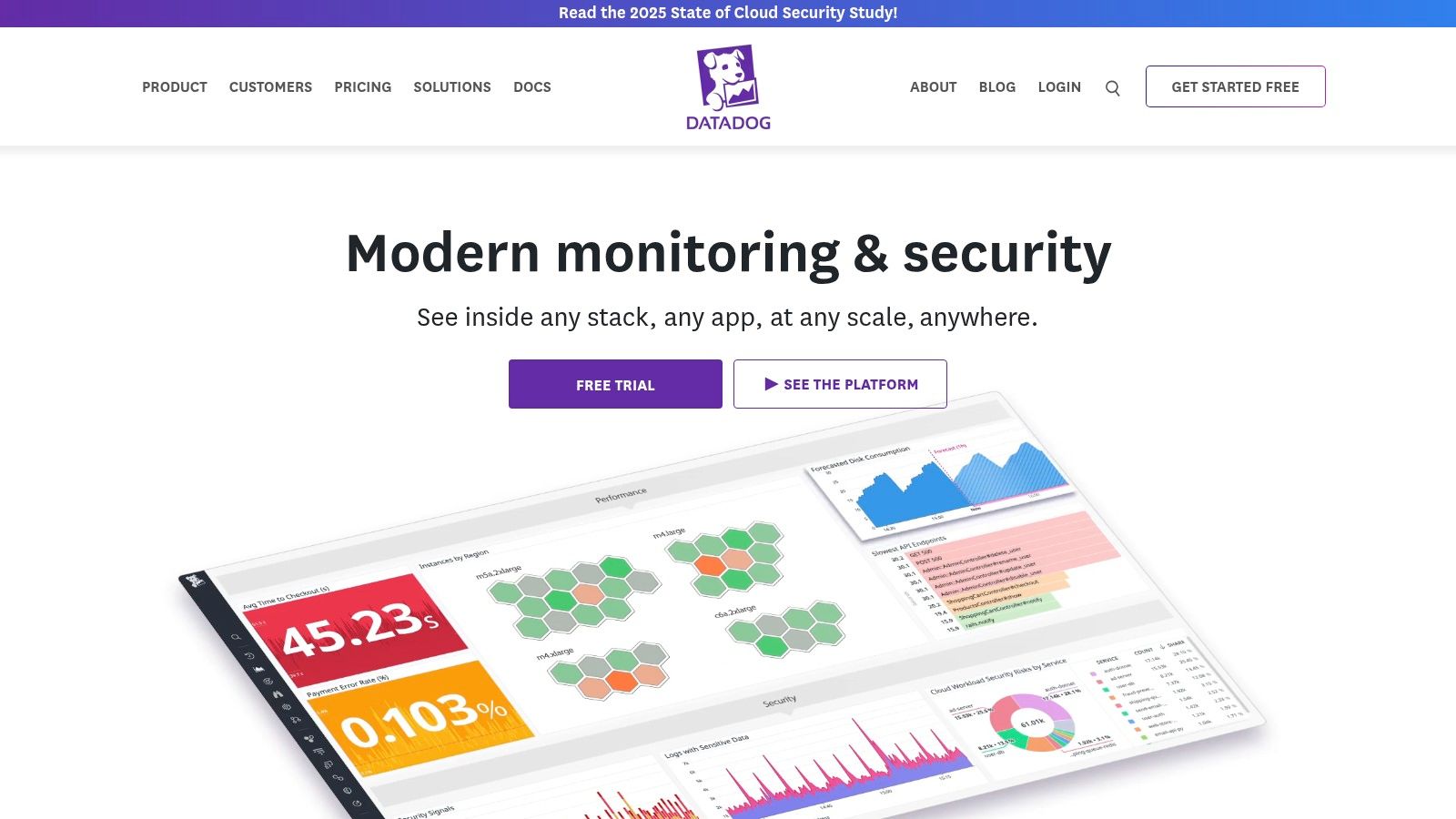
Datadog’s core advantage is its “single pane of glass” philosophy. Instead of isolating AI metrics, it lets you trace an LLM-powered request from the initial user click all the way through your microservices and down to the model's response. This end-to-end visibility is critical for diagnosing complex issues where the root cause might be a slow database query, not the LLM itself.
Key Features and Use Cases
- End-to-End Tracing: Trace every step of your LLM agents, linking model performance to overall application and infrastructure metrics. A SaaS team could use this to identify that a chatbot’s slow response time is caused by a bottleneck in an external API call, not the language model.
- Experimentation and Optimization: Evaluate and compare different prompts, models, or parameters to optimize for speed, cost, and quality. This helps marketing teams fine-tune content generation models. As you monitor these outputs, you are effectively engaging in a form of Answer Engine Optimization.
- Safety and Quality Guardrails: Monitor and flag sensitive data (PII), toxic language, or other quality issues in model outputs, ensuring brand safety.
Pricing and Access
Datadog's pricing is comprehensive and tailored for businesses that require its full-stack observability suite. Specific LLM Observability pricing details require contacting sales, but the model typically involves annual billing minimums and is based on monthly request volumes.
- Pros: Single platform for app, LLM, and infrastructure metrics; mature enterprise security and compliance features.
- Cons: Can be expensive for teams not using the broader Datadog platform; annual billing minimums may be a barrier for smaller startups.
Website: https://www.datadoghq.com
5. WhyLabs
WhyLabs is an AI observability platform with a strong emphasis on privacy, data quality, and model health monitoring. It excels at detecting data drift, anomalies, and quality degradation before they impact your AI's output.
It’s a leading ai visibility metrics platform for monitoring both traditional machine learning models and complex LLM applications without exposing sensitive user data.
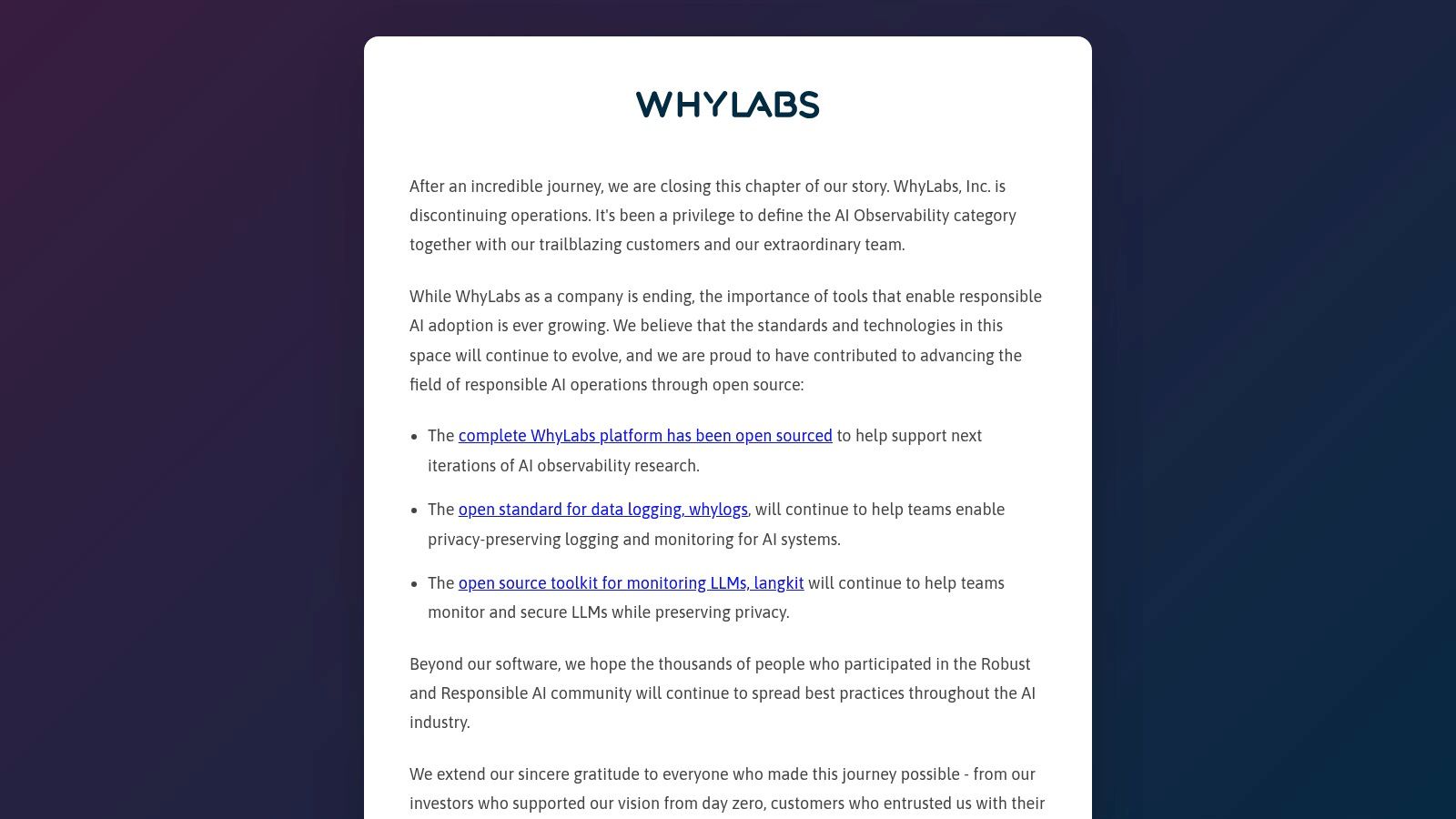
Its core differentiator is a privacy-first approach using its open-source whylogs library. This allows your systems to generate statistical profiles of data locally and send only those anonymized profiles to the WhyLabs platform for analysis. This is crucial for industries with strict compliance requirements, as it ensures visibility into model behavior without ever moving or storing the raw data.
Key Features and Use Cases
- Drift & Anomaly Detection: Automatically monitors data inputs and model outputs for statistical changes. A SaaS marketing team could get an alert when the demographics of users interacting with their AI chatbot suddenly change, signaling a shift in their audience share of voice.
- LLM Guardrails: Set up policies to monitor and flag LLM misuse, cost overruns, or the presence of PII in prompts or responses.
- Unified Monitoring: Provides a single dashboard to oversee a mixed stack of traditional ML models (like lead scoring) and generative AI applications.
Pricing and Access
WhyLabs offers a free "Starter" plan for individuals and small teams, which includes monitoring for up to two models. For larger teams, they provide "Pro" and custom "Enterprise" plans. Pricing for these higher tiers requires contacting their sales team.
- Pros: Strong privacy-first architecture, excellent for mixed ML and LLM environments, robust drift detection.
- Cons: Advanced plan pricing is not publicly listed; significant customization may require more initial setup.
Website: https://whylabs.ai
6. Fiddler AI
Fiddler AI is a responsible AI platform focused on ensuring trust, safety, and transparency in production AI systems. Fiddler distinguishes itself with deep governance capabilities, making it a leading ai visibility metrics platform for teams concerned with bias, fairness, and real-time moderation.
It provides the necessary guardrails to deploy generative AI applications confidently.
Its core strength is in providing a comprehensive suite for responsible AI. Fiddler’s platform helps you analyze model behavior, detect data drift, and get to the root cause of any performance issues with powerful explainability tools. This is particularly crucial for SaaS companies using AI for customer-facing features, where understanding why an AI made a certain decision is vital.
Key Features and Use Cases
- Real-time GenAI Moderation: Implement safety guardrails with latency under 100ms to moderate inputs and outputs for toxicity, PII, and other harmful content. A SaaS team could use this to ensure their AI-powered community forum assistant doesn't generate inappropriate responses.
- Fairness and Bias Analytics: Continuously monitor models for bias across sensitive demographic groups. This is essential for AI-driven lead scoring or personalization engines.
- Drift Detection & Explainability: Get alerted when the distribution of production data changes significantly from the training data. Its root cause analysis tools help you understand which features are driving model predictions or failures.
Pricing and Access
Fiddler AI's pricing structure is primarily enterprise-focused. It offers a "Lite" tier for individuals and startups, but the "Business" and "Enterprise" plans require contacting their sales team for a custom quote.
- Pros: Strong governance and responsible AI capabilities, real-time safety features for production LLM applications.
- Cons: Pricing is sales-led for most plans; advanced features are geared towards enterprise customers.
Website: https://www.fiddler.ai
7. Weights & Biases (W&B)
Weights & Biases (W&B) is a comprehensive developer-first MLOps platform for tracking, visualizing, and managing machine learning projects. Its expansion into LLM-specific tools makes it a powerful leading ai visibility metrics platform for teams building sophisticated AI systems.
W&B provides the infrastructure to trace, evaluate, and compare LLM-powered application runs, offering deep insights into performance and cost.
Its core advantage is bridging the gap between development and production. Teams can track every experiment, log all relevant artifacts (like datasets and model weights), and then use the same platform to monitor the production application’s performance. This creates a unified system of record that ensures reproducibility and simplifies debugging.
Key Features and Use Cases
- LLM Tracing & Evaluation: Automatically log and visualize the entire lifecycle of your LLM calls. A SaaS team can use this to compare the latency and token costs of different LLMs (like GPT-4 vs. Claude 3) for their customer support bot, directly tying performance metrics to specific model versions.
- Experiment Tracking & Sweeps: Systematically log hyperparameters, metrics, and outputs for every training run. This is essential for fine-tuning a proprietary model for a marketing slogan generator.
- Artifacts & Lineage: Store, version, and track datasets, models, and prompts. This feature provides a full audit trail, showing exactly which data was used to create which model, a critical capability for compliance.
Pricing and Access
W&B offers a generous free tier for individuals and academic use. For teams, paid plans are structured by product usage, with separate pricing for experiment tracking, model registry, and LLM monitoring tools. This modular approach allows teams to start small.
- Pros: Robust, widely adopted MLOps toolset; strong community support; modular pricing.
- Cons: Can be more complex than needed for simple applications; costs can increase with heavy artifact storage.
Website: https://wandb.ai
8. Langfuse
Langfuse is an open-source LLM engineering platform that combines observability, analytics, and evaluation. It offers both a self-hosted option and a managed cloud service, making it a flexible leading ai visibility metrics platform for teams of all sizes.
Its strength lies in providing detailed, low-level tracing of LLM application requests, allowing teams to debug issues, analyze performance, and understand costs with precision.
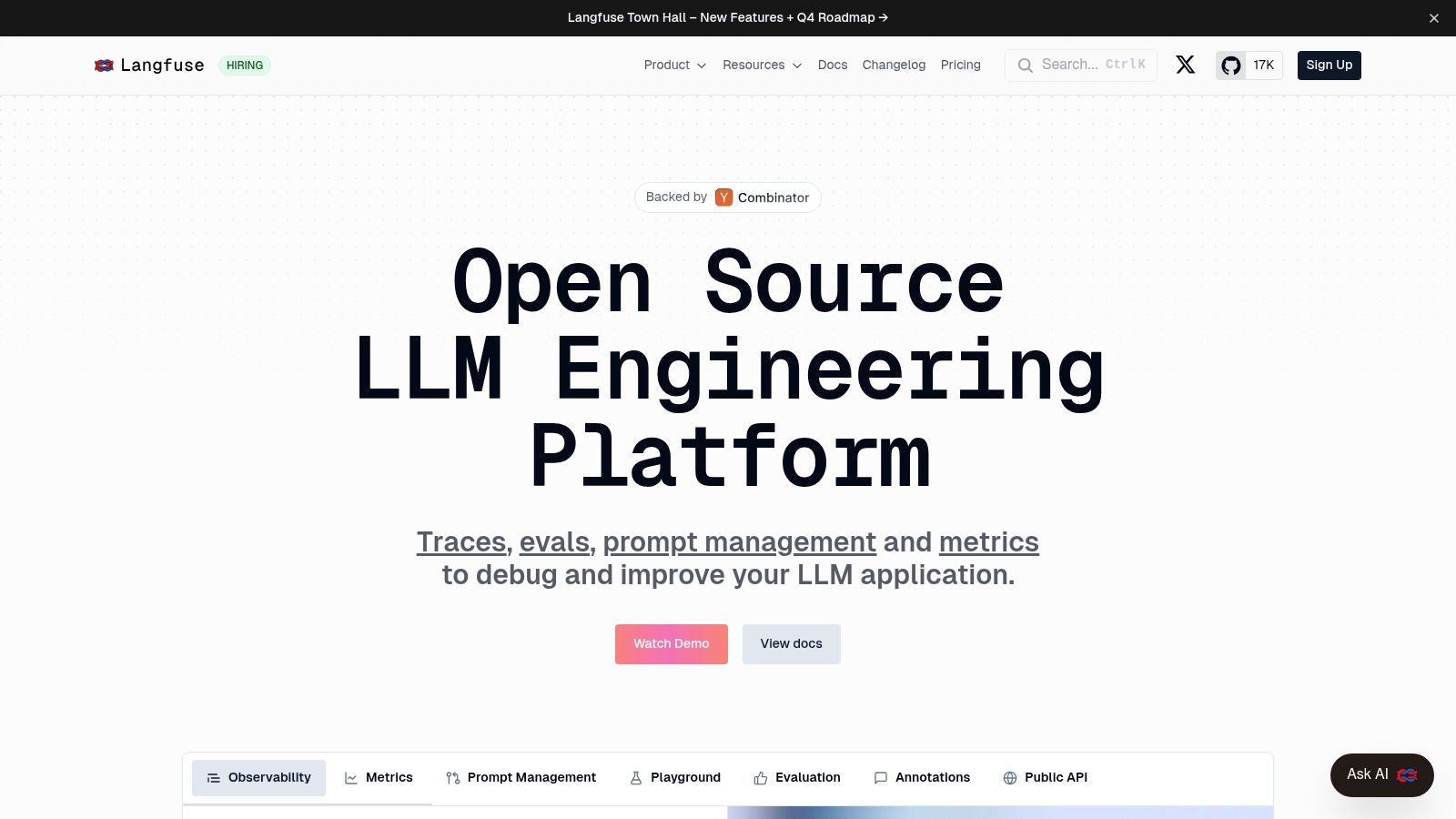
Langfuse is model and framework-agnostic, integrating with libraries like LangChain, LlamaIndex, and OpenAI. This makes it an excellent choice for teams using a diverse tech stack. The platform is designed to trace every step of an AI interaction, capturing prompts, completions, latency, and token usage.
Key Features and Use Cases
- Detailed Tracing: Capture end-to-end traces of complex LLM chains. A SaaS company can use this to diagnose why their customer support bot is providing slow answers by inspecting every model call within a single user conversation.
- Prompt Management: Version, manage, and deploy prompts directly from the Langfuse UI. This helps a marketing team collaboratively test different prompt variations for their AI-powered content creation tool.
- LLM Evaluations: Create datasets from production traces and run evaluations to score the quality of model outputs. This is useful for systematically testing a new language model against a set of benchmark questions before rolling it out.
Pricing and Access
Langfuse offers a "Hobby" plan for its cloud service, which is free and includes up to 50,000 observations per month. The "Pro" plan provides more observations and features for growing teams, with transparent, usage-based pricing. The core platform can be self-hosted for free under an MIT license.
- Pros: Strong open-source offering with self-hosting, model and framework agnostic, generous free plan.
- Cons: Advanced features like role-based access control are part of the paid enterprise license; high-volume usage can become costly on paid plans.
Website: https://langfuse.com
9. Evidently AI
Evidently AI is an open-source-first evaluation and monitoring platform designed to bring clarity to AI systems. It provides a powerful, extensible framework for evaluating everything from traditional machine learning models to complex LLM-based applications.
Its strength as a leading ai visibility metrics platform comes from its comprehensive suite of built-in tests and detailed visual reports. This makes it accessible for teams that need robust monitoring without being locked into a single vendor.
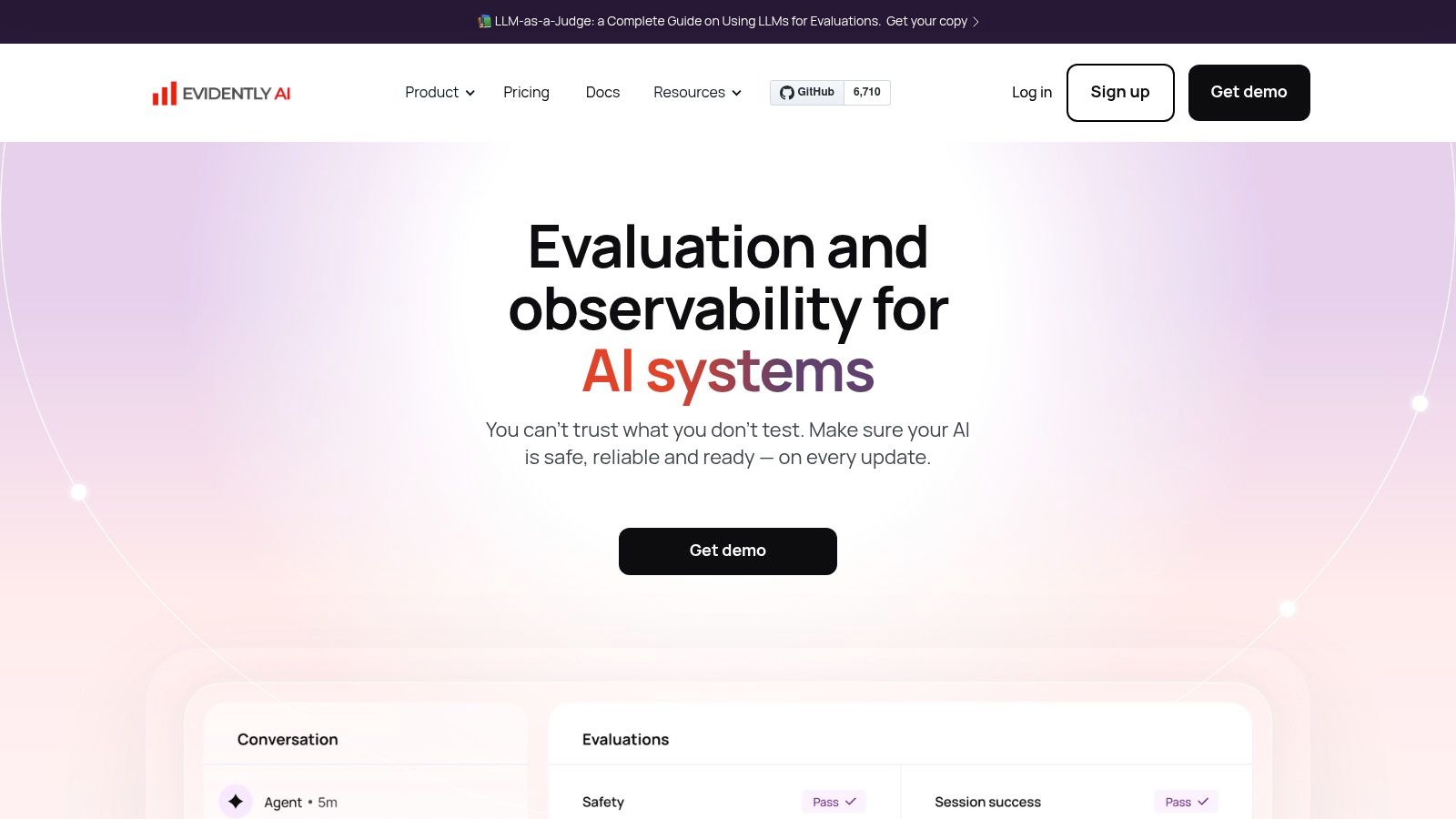
The platform is built on open-source libraries that can be self-hosted. For teams seeking a managed solution, Evidently Cloud provides tracing, managed datasets, and advanced features. This dual approach allows a startup to begin with the open-source version for free and scale to the managed cloud service as their needs grow.
Key Features and Use Cases
- 100+ Evaluation Metrics: Offers a massive library of pre-built metrics and reports for data drift and model quality. A SaaS team can use these to monitor if the user demographics their lead-scoring AI was trained on are drifting away from current sign-ups.
- Synthetic Data Generation: Create high-quality synthetic data to test for safety, quality, and potential biases in your AI applications. This is crucial for testing how a content personalization engine handles edge cases before it interacts with real users.
- Offline and Online Evaluations: Analyze model performance on historical data (offline) and monitor live production traffic (online). This allows teams to both validate a new AI-powered SEO tool in development and continuously track its accuracy once deployed.
Pricing and Access
Evidently's open-source tools are free. The managed Evidently Cloud offers a transparent, usage-based model with a free tier that includes 2,000 trace rows per month. Paid plans are billed based on row and storage consumption.
- Pros: Strong open-source foundation, transparent cloud pricing, extensive library of built-in metrics.
- Cons: Row-based cloud billing can be difficult to estimate initially; some enterprise features require private cloud deployment.
Website: https://www.evidentlyai.com
10. Helicone
Helicone is an open-source LLM observability platform designed for teams that need granular control over their data. It specializes in request-level logging, cost tracking, and prompt management, making it a strong leading ai visibility metrics platform for developers focused on performance and security.
Its key differentiator is the option for self-hosting and its SOC 2 compliance, appealing to companies with stringent data privacy requirements.
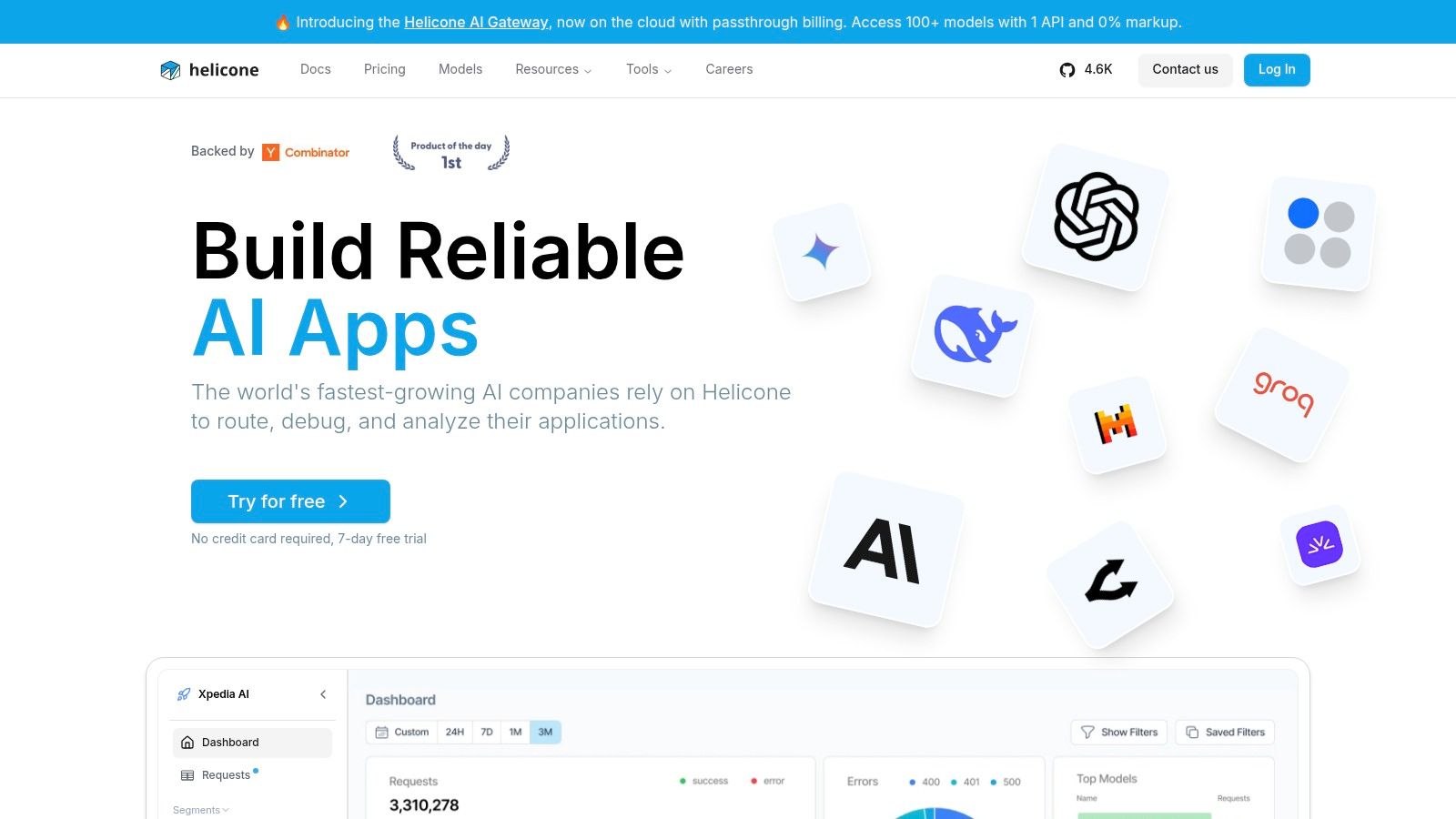
The platform provides detailed dashboards to monitor metrics like latency, cost per request, and token usage across different models. This visibility helps teams quickly identify performance bottlenecks or unexpected cost spikes. For a SaaS company using an AI-powered feature for in-app support, Helicone can immediately flag if a new model version is significantly slower or more expensive than the previous one.
Key Features and Use Cases
- Observability & Analytics: Get a clear overview of all LLM requests with comprehensive dashboards. Teams can filter by custom properties, such as user ID, to debug specific interactions.
- Prompt Management & Experimentation: Create, version, and A/B test prompt templates directly within the platform. This allows marketing teams to experiment with different phrasings for a content summarization tool.
- SOC 2 Compliance & Self-Hosting: For organizations in regulated industries, the ability to deploy Helicone on-premises provides maximum data control. This ensures that sensitive user inputs never leave the company's own secure environment.
Pricing and Access
Helicone has a free tier that supports up to 100,000 requests per month, making it excellent for startups and development-phase projects. Beyond the free tier, pricing is usage-based.
- Pros: High-volume free tier, open-source with a self-hosting option, strong focus on data security.
- Cons: Pricing beyond the free tier can be less transparent (sales or usage-based); smaller ecosystem compared to larger platforms.
Website: https://www.helicone.ai
11. Google Cloud Vertex AI – Model Monitoring
Google Cloud's Vertex AI Model Monitoring is an enterprise-grade solution for teams operating within the GCP ecosystem. It provides deep visibility into the health and performance of deployed machine learning models, making it a crucial leading ai visibility metrics platform for maintaining model integrity.
It specializes in detecting data drift and skew, ensuring your AI systems continue to perform reliably as real-world data evolves.
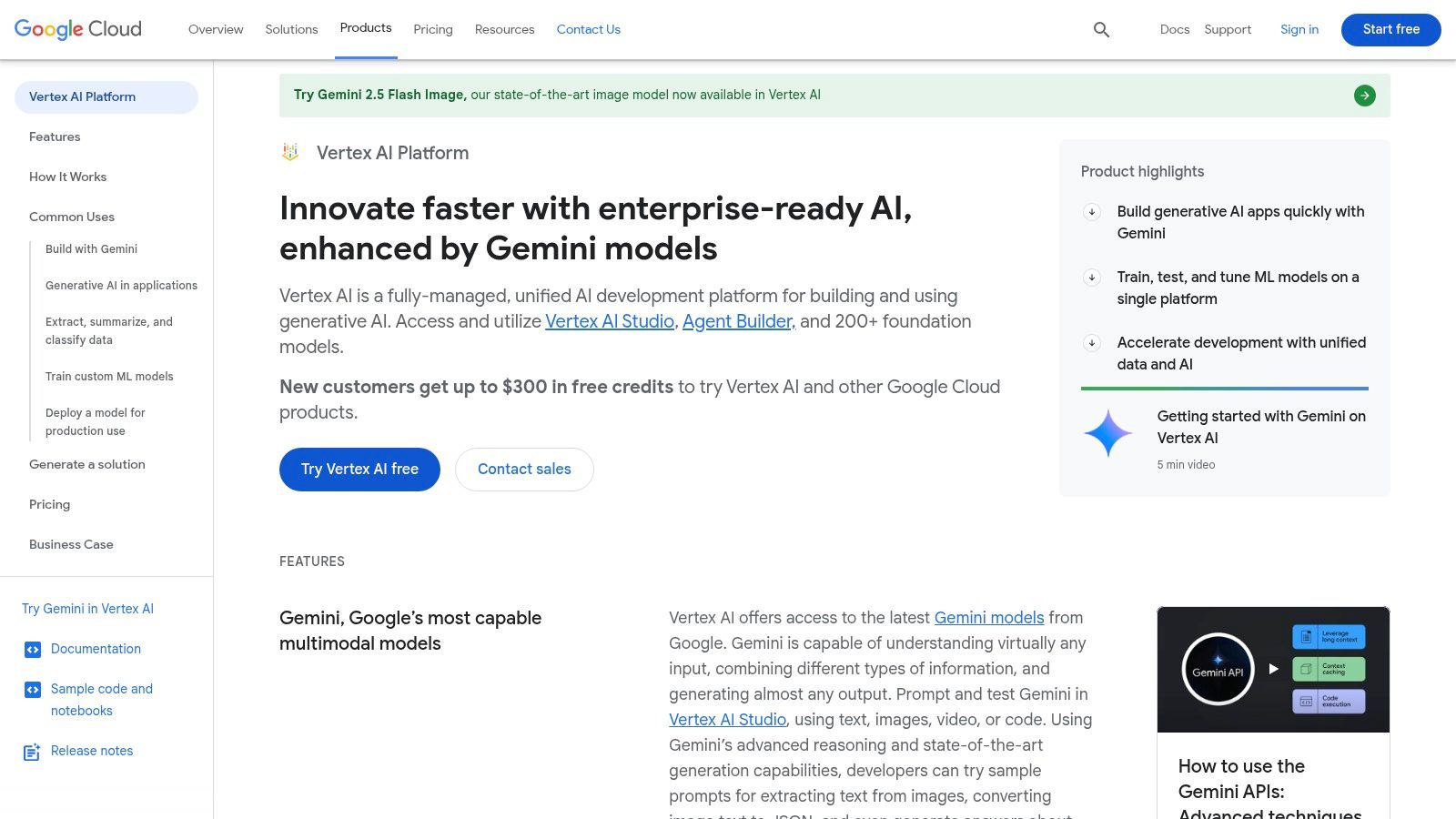
Its primary strength is its native integration with other Google Cloud services like BigQuery and Cloud Logging. This allows for a seamless workflow from model training to production monitoring, all under a single security framework. For organizations already invested in Google Cloud, adopting this tool is a natural extension.
Key Features and Use Cases
- Drift and Skew Detection: Automatically monitor for deviations between your model's training data and the live prediction data it receives. A SaaS company could use this to get alerts if the user behavior data feeding its churn prediction model starts to differ significantly.
- Integrated Prediction Logging: All prediction requests and responses can be automatically logged to BigQuery tables for analysis. A marketing team can analyze the inputs given to a lead-scoring model and cross-reference them with actual conversion data to identify performance gaps.
- Explainable AI Integration: Understand feature attributions to see which inputs are most influential in a model's predictions.
Pricing and Access
Vertex AI Model Monitoring has a transparent, usage-based pricing model, primarily billed per gigabyte of data analyzed. Costs are separate from other GCP services like BigQuery storage, which are billed according to their own rates.
- Pros: Deep integration with the Google Cloud ecosystem, enterprise-grade security and compliance, transparent per-GB cost structure.
- Cons: Best suited for teams already on GCP; setup requires familiarity with the Google Cloud platform.
Website: https://cloud.google.com/vertex-ai
12. Microsoft Azure AI Foundry – Observability
For organizations deeply embedded in the Microsoft ecosystem, Azure AI Foundry – Observability provides a native, enterprise-grade solution for monitoring AI applications. It integrates directly into the Azure cloud fabric, leveraging services like Azure Monitor and Application Insights.
This makes it a strong contender for the title of a leading ai visibility metrics platform for any team already running their tech stack on Azure.
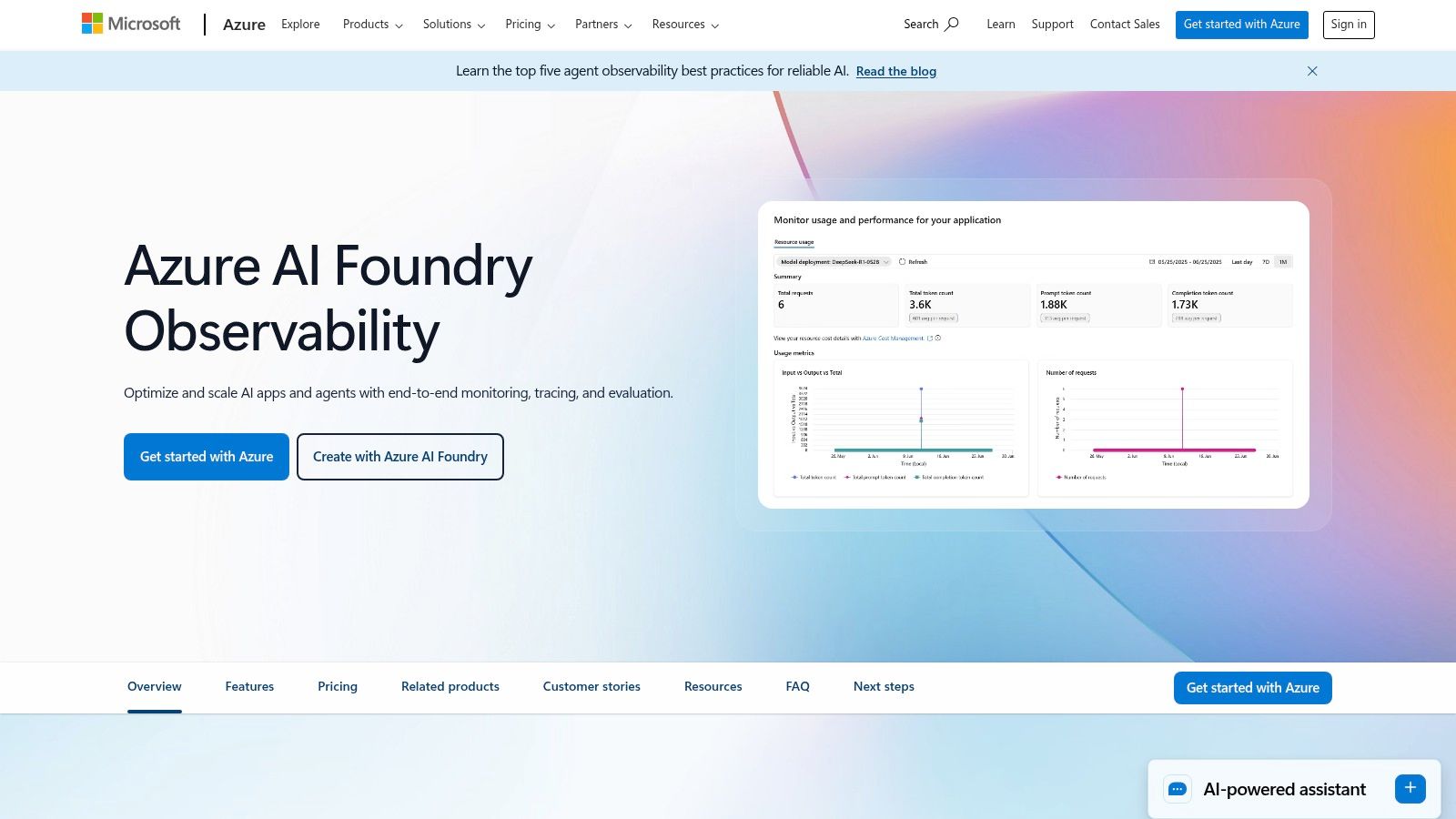
Its primary differentiator is its focus on enterprise security and content safety. The platform provides built-in AI safety guardrails, including prompt shields and safety evaluators that integrate with Azure Content Safety. This allows teams to monitor for and mitigate risks like hate speech in real-time.
Key Features and Use Cases
- Integrated Tracing and Evaluation: All traces and evaluation metrics are stored and analyzed within Azure Application Insights. This means a DevOps team can use existing dashboards to monitor AI application health alongside their traditional cloud infrastructure.
- AI Safety Guardrails: Use prompt shields and safety evaluators to protect against harmful content and prompt injection attacks. This is crucial for a marketing team deploying an interactive AI-powered campaign.
- Token-Based Evaluation Pricing: Costs for running evaluations are calculated based on the number of input and output tokens processed.
Pricing and Access
Pricing for Azure AI Foundry – Observability is component-based and can be complex. Costs are spread across multiple Azure services, including Application Insights for data storage and Azure AI services for evaluation processing. Users will need to use the Azure pricing calculator to estimate total costs.
- Pros: Seamless integration for Azure-native stacks, robust enterprise-level security and compliance.
- Cons: Pricing is complex and distributed across multiple Azure products, making it difficult to estimate total cost.
Website: https://azure.microsoft.com/products/ai-foundry/observability
Leading AI Visibility Metrics Platforms Feature Comparison
| Platform | Core Features / Focus | User Experience / Quality ★ | Value Proposition 💰 | Target Audience 👥 | Unique Selling Points ✨ |
|---|---|---|---|---|---|
| AI SEO Tracker 🏆 | AI SEO rankings across major LLMs; Content & prompt analysis; ROI calculator | ★★★★☆ | Pricing on request 💰💰 | SaaS marketing teams, SEO managers, agencies 👥 | Tracks AI SEO-specific visibility; Page Inspector with action plans; Outcome-focused insights ✨ |
| LangSmith by LangChain | LLM/agent observability; tracing & evaluations | ★★★★☆ | Clear trace-based pricing 💰💰 | LangChain users, AI dev teams 👥 | Deep LangChain integration; human & AI judges ✨ |
| Arize AI (Phoenix + AX) | Model & LLM observability; open-source/self-hosted | ★★★★☆ | Free tier + usage pricing 💰 | AI/ML teams needing flexible deployment 👥 | Open-source option; drift detection; custom metrics ✨ |
| Datadog LLM Observability | Full-stack monitoring; LLM app tracing & performance | ★★★★☆ | Enterprise pricing with minimums 💰💰💰 | Enterprises with DevOps & AI needs 👥 | Unified app + LLM + infra metrics; security features ✨ |
| WhyLabs | Privacy-first AI & LLM monitoring; drift & anomaly | ★★★★☆ | Sales contact needed 💰💰 | Data-sensitive orgs; mixed ML/LLM stacks 👥 | Privacy-preserving telemetry; AI misuse guardrails ✨ |
| Fiddler AI | Responsible AI monitoring; fairness & explainability | ★★★★☆ | Sales-led pricing 💰💰 | Enterprises focused on AI governance 👥 | Real-time GenAI moderation; bias & explainability tools ✨ |
| Weights & Biases (W&B) | Experiment tracking; LLM evals; artifact management | ★★★★☆ | Free/Pro transparent plans 💰 | MLOps teams, AI developers 👥 | Dev-to-prod visibility; strong community support ✨ |
| Langfuse | Open-source/cloud LLM observability; prompt mgmt | ★★★★☆ | Free Hobby + affordable Core plans 💰 | AI devs wanting self-hosted or cloud options 👥 | Open-source MIT licensed core; prompt/version management ✨ |
| Evidently AI | Open-source AI evals & monitoring; synthetic data | ★★★★☆ | Transparent cloud add-ons 💰 | AI teams needing rich metrics & safety checks 👥 | 100+ metrics; synthetic data generation ✨ |
| Helicone | LLM observability; prompt experimentation; SOC 2 | ★★★★☆ | Free tier + usage pricing 💰 | Startups, nonprofits, prototyping teams 👥 | High free volume; simple pricing; on-prem option ✨ |
| Google Cloud Vertex AI | Managed model monitoring; drift/skew/attribution | ★★★★☆ | Transparent per-GB pricing 💰💰 | Google Cloud users; enterprises 👥 | Tight GCP integration; enterprise security ✨ |
| Microsoft Azure AI Foundry | Token-based evaluation & tracing; safety guardrails | ★★★☆☆ | Complex pricing across Azure 💰💰 | Azure-native AI teams 👥 | AI safety evaluators; prompt shields ✨ |
Your Next Step: From Measuring to Winning
The core takeaway is clear: visibility in the age of AI is the central nervous system of your content strategy. Simply tracking keyword ranks is an obsolete approach when your audience gets answers directly from large language models. The battle has moved from the SERP to the AI's response box.
Choosing the right leading ai visibility metrics platform from this list isn't about finding the "best" tool. It's about finding the best fit for your team's context, technical maturity, and goals.
How to Choose Your Platform: A Practical Framework
Your decision should hinge on a few key questions.
1. Who is the primary user?
- For Marketing & SEO Teams: Your focus should be on platforms with intuitive dashboards that translate complex data into actionable content insights. Tools like AI SEO Tracker are built specifically for this user, answering questions like, "Is our brand mentioned in AI answers for 'best project management software'?"
- For Data Science & Engineering Teams: If your company builds its own LLM-powered applications, you need deep, granular observability. Platforms like LangSmith, Arize AI, and Fiddler AI provide the tools to debug prompts, track token usage, and monitor for model drift.
2. What is your most immediate problem?
- Problem: "We have no idea if our content appears in ChatGPT or Perplexity."
- Solution: Start with a dedicated AI SEO visibility platform. These tools are purpose-built to track your brand's presence, share of voice, and source citations within generative AI responses.
- Problem: "Our custom-built AI chatbot is giving inaccurate answers and we don't know why."
- Solution: You need a true LLM observability tool like Langfuse or Helicone to trace request-response cycles, analyze latency, and evaluate the quality of outputs.
Implementation: From Decision to Data
Once you select a platform, the real work begins. Implementation isn't just about signing a contract; it's about integrating the tool into your team's workflow.
Case Study 1: B2B SaaS Demand Generation A marketing team at a project management SaaS company implemented AI SEO Tracker. Every Monday, they review which of their blog posts are being cited by AI models for queries like "best task management tools." When a new post about "Kanban vs. Scrum" gets picked up, they immediately double down, creating a follow-up webinar and a social media campaign around that now-validated topic. This transforms the platform from a passive monitor into an active driver of their content calendar.
Case Study 2: E-commerce Product Marketing An e-commerce company selling sustainable apparel used a platform to monitor how AI models describe its products versus competitors. They discovered that LLMs consistently omitted their product's key differentiator: "made with GOTS-certified organic cotton." The content team received a clear, data-backed directive. Their next task was to update product pages and informational content to explicitly and repeatedly highlight that feature, aiming to retrain the AI's understanding.
The era of passive content creation is over. We're now in a direct dialogue with the AI models that shape how the world finds information. The tools we've covered provide the data needed to move from guessing to knowing, and from measuring to winning. Your next step is to choose your lens, start tracking, and begin shaping the answers your future customers will see.
If your primary goal is to understand and improve how your brand, content, and products appear in AI chat responses, you need a tool built for that exact purpose. While MLOps platforms are powerful, they are often overkill for marketing teams. AI SEO Tracker provides the focused insights you need without the engineering overhead. Start tracking your AI visibility today and turn metrics into market share with AI SEO Tracker.

